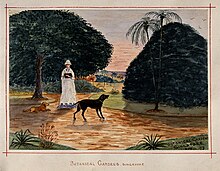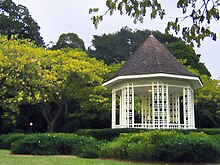Singapore Botanic Gardens
| Singapore Botanic Gardens | |
|---|---|
|
UNESCO world heritage |
|

|
|
| National territory: |
|
| Type: | Culture |
| Criteria : | (ii) (iv) |
| Surface: | 49 hectares |
| Buffer zone: | 137 ha |
| Reference No .: | 1483 |
| UNESCO region : | Asia and Pacific |
| History of enrollment | |
| Enrollment: | 2015 ( session 39 ) |
Singapore Botanic Gardens ( Singapore Botanic Gardens ) is one of the most important botanical gardens of Asia . It is 74 hectares and is the most visited botanical garden in the world with 4.2 million visitors annually. In 2015, the garden was the first site in Singapore to be included in the UNESCO World Heritage List .
history
Sir Stamford Raffles founded a botanical garden on Government Hill (Fort Canning Hill) in 1822 and tried to grow mainly economically important goods such as cocoa and nutmeg . After Raffle's death, the garden closed in 1829 because it was not financially secure.
The present garden was founded in 1859 by the Scot Lawrence Niven from Dumfriesshire . In 1874 the garden came under state control and in 1888 the first director, Henry Nicholas Ridley, was hired. Today he is best known for his interest in rubber production. The garden provided plants for Malaysia's plantations during the rubber boom .
In the mid-1960s, the then Prime Minister Lee Kuan Yew initiated extensive planting of street trees. Singapore should become the greenest city in Asia. The Botanical Garden was significantly included in the program with its advisory skills and as a supplier of plants. In 1973 he joined the Parks and Trees department of the Public Works Department , which was now called the Parks and Recreation Department , with the aim of making Singapore a garden city, among other things. In 1988 Tan Wee Kiat became director of the garden and put another focus on the scientific, internationally oriented work of the garden. Since 1990 the gardens have been subordinate to the newly formed National Parks Board . The garden also maintains the Singapore Herbarium (SING) with around 650,000 specimens.
Entry is free (except for the orchid garden) and the garden is open daily from 5 a.m. to midnight. Among other things, it is used by the population for morning exercise based on the Chinese model. Concerts are also held regularly.
management
- Henry Nicholas Ridley, 1888–1911, also known as "Mad Ridley" or "Rubber Ridley"
- Eric Holttum, 1925–1949, was mainly concerned with growing orchids
- Tan Wee Kiat, 1988
- Chin See Chung, 1996
- currently (2013) Nigel Taylor
World Heritage
The botanical garden was registered as a world cultural heritage in the list of UNESCO world heritage in 1995 on the basis of a resolution of the 19th session of the World Heritage Committee under the name Singapore Botanical Gardens . This makes it the first and, as of 2016, the only World Heritage Site in Singapore that ratified the World Heritage Convention in 2012. The following year, the World Heritage Site was renamed the Singapore Botanic Gardens
The reasoning for the decision states, among other things:
Singapore Botanic Gardens in the heart of the city of Singapore show the development of a British colonial tropical botanical garden from a "Pleasure Garden" in the English landscape style to a colonial commercial garden with facilities for horticulture and botanical research, to a modern, world-class botanical garden scientific institution and a place of preservation, recreation and education. Singapore Botanic Gardens is a well-defined cultural landscape that encompasses a rich variety of historical landscape features, plantings and buildings that clearly show the evolution of the Botanic Gardens since its inception in 1859. With its well-preserved landscaping and continuity of purpose, the Singapore Botanic Gardens is an excellent example of a British tropical botanical garden that is also one of the best in the fields of scientific knowledge, particularly tropical botany and horticulture, including the development of plantation rubber Played a key role.
The entry was made on the basis of criteria (ii) and (iv).
(ii): Singapore Botanic Gardens has been a center of plant research in Southeast Asia since the 19th century, made a significant contribution to the expansion of plantation gum in the 20th century, and continues to play a leading role in the exchange of ideas, expertise and expertise in tropical botany and Horticultural Sciences. While the UK's Kew Botanic Gardens were providing the first seedlings, the Singapore Botanic Gardens provided the conditions for their planting, development and distribution throughout Southeast Asia and elsewhere.
(iv): Singapore Botanic Gardens is a prime example of a British colonial tropical botanical garden and has been noted for its preserved landscaping and continuity of purpose since its inception
The World Heritage Site spans much of the Singapore Botanic Gardens. The reserve has an area of 49 ha . The rest of the Singapore Botanic Gardens and an adjacent area surround the reserve as a buffer zone with an area of 137 hectares.
See also
Individual evidence
- ↑ World Heritage: Iran and Singapore are happy , fnp.de, July 4, 2015, accessed on July 12, 2015.
- ^ Robin Lane Fox: The Kew of the east , Financial Times , February 15, 2013, accessed July 12, 2015.
- ↑ a b c Decision: 39 COM 8B.17. In: whc.unesco.org. UNESCO World Heritage Center, accessed May 1, 2017 .
- ↑ Singapore. In: whc.unesco.org. UNESCO World Heritage Center, accessed May 1, 2017 .
- ↑ Decision: 40 COM 8B.49. In: whc.unesco.org. UNESCO World Heritage Center, accessed May 1, 2017 .
- ↑ Singapore Botanic Gardens. Maps. In: whc.unesco.org. UNESCO World Heritage Center, accessed June 22, 2017 .
- ↑ Singapore Botanic Gardens. In: whc.unesco.org. UNESCO World Heritage Center, accessed May 1, 2017 .
Web links
- Website of the Botanical Garden
- Seokguram Temple and Bulguksa Temple on the UNESCO World Heritage Center website ( English and French ).
Coordinates: 1 ° 18'53 " N , 103 ° 48'58" E






